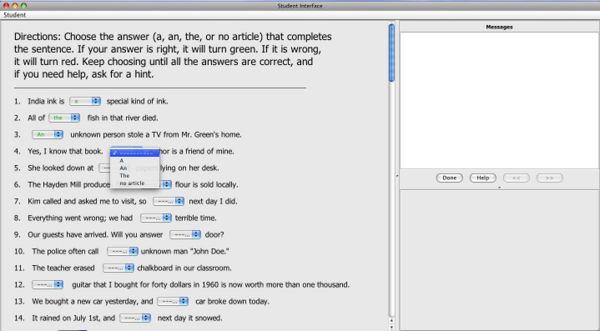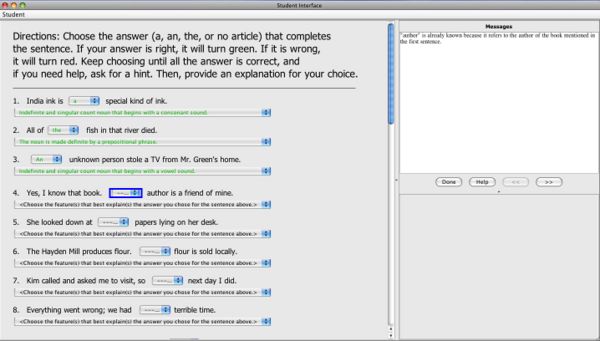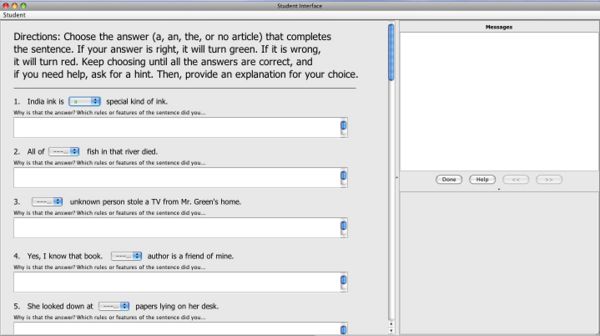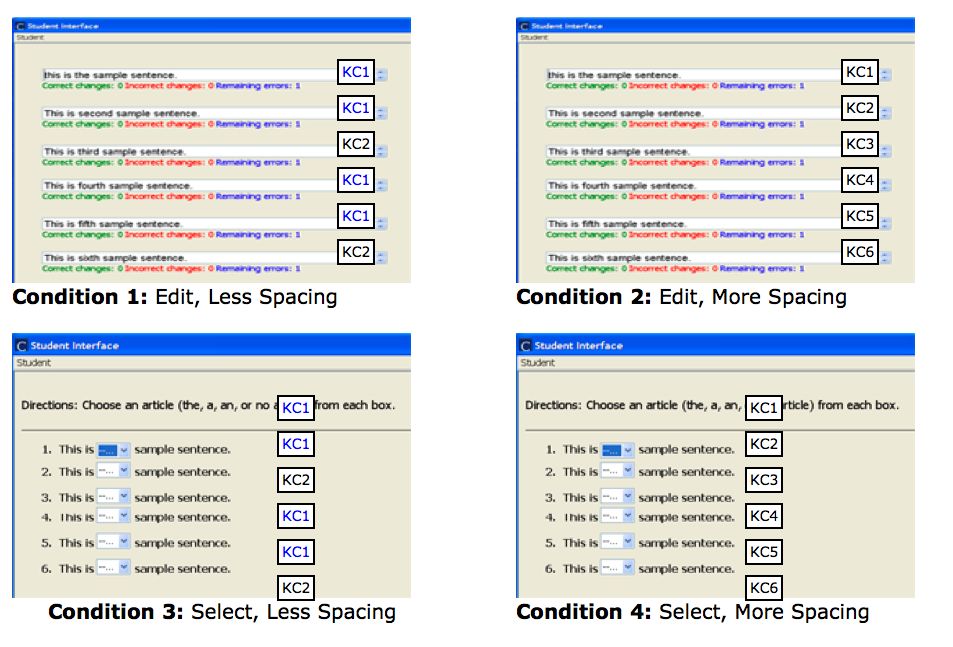Difference between revisions of "Assistance Dilemma English Articles"
Ruth-Wylie (talk | contribs) (→Dependent Variables) |
Ruth-Wylie (talk | contribs) (→Intelligent Writing Tutor) |
||
| Line 33: | Line 33: | ||
The project focuses on exploring general principles of learning along three different dimensions of assistance: 1) task type: a) edit vs. b) selection; 2) spacing: a) more spacing vs. b) less spacing, and 3) self-explanation: a) problems only vs. b) problems with prompts to self-explain. We instantiate these principles within the domain of the English article system and within the English as a Second Language LearnLab. In this domain, standard practice often uses the (a) values on the three dimensions above (edit of multiple knowledge components with no self-explanation) whereas emerging PSLC theory and analysis predict that the (b) values on the three dimensions (selection on a subset of knowledge components with self-explanation) will lead to greater robust learning outcomes. These dimensions are interesting for exploring a priori predictions as to whether adding difficulties (removing assistance) during instruction aids or harms eventual learning outcomes. For the task type and spacing dimensions, our standing theoretical prediction is that the added demand editing and greater spacing (dimensions 1a and 2a) hurt learning, while the added demand of self-explanation (dimension 3b) helps learning. | The project focuses on exploring general principles of learning along three different dimensions of assistance: 1) task type: a) edit vs. b) selection; 2) spacing: a) more spacing vs. b) less spacing, and 3) self-explanation: a) problems only vs. b) problems with prompts to self-explain. We instantiate these principles within the domain of the English article system and within the English as a Second Language LearnLab. In this domain, standard practice often uses the (a) values on the three dimensions above (edit of multiple knowledge components with no self-explanation) whereas emerging PSLC theory and analysis predict that the (b) values on the three dimensions (selection on a subset of knowledge components with self-explanation) will lead to greater robust learning outcomes. These dimensions are interesting for exploring a priori predictions as to whether adding difficulties (removing assistance) during instruction aids or harms eventual learning outcomes. For the task type and spacing dimensions, our standing theoretical prediction is that the added demand editing and greater spacing (dimensions 1a and 2a) hurt learning, while the added demand of self-explanation (dimension 3b) helps learning. | ||
| − | |||
| − | |||
| − | |||
| − | |||
=== Study 1: Self-Explanation Study === | === Study 1: Self-Explanation Study === | ||
| Line 55: | Line 51: | ||
Image 3: Free-form Self-Explanation Tutor- Using this tutor, students select an article (a, an, the, no article) from each sentence and write an explanation for why they made their choice. | Image 3: Free-form Self-Explanation Tutor- Using this tutor, students select an article (a, an, the, no article) from each sentence and write an explanation for why they made their choice. | ||
| − | ==== | + | ==== Learning Measures ==== |
This study uses a combination of normal and robust learning measures. Normal learning measures include pre and posttests with questions analogous to those used in the tutors. Robust learning measures include article use of RSAs (Recorded Speaking Activity). | This study uses a combination of normal and robust learning measures. Normal learning measures include pre and posttests with questions analogous to those used in the tutors. Robust learning measures include article use of RSAs (Recorded Speaking Activity). | ||
| − | === Study 2: | + | === Study 2: Spacing of Knowledge Component Learning Events === |
| − | + | The second study, conducted in Spring 2009 in Levels 3, 4, and 5 of the English LearnLab will investigate the effects of various temporal spacing between knowledge components. Students will be randomly assigned to one of four conditions: | |
| + | |||
| + | |||
==== Hypothesis ==== | ==== Hypothesis ==== | ||
Students who complete sentence-length exercises will show greater robust learning than students who complete paragraph-length exercises. Furthermore, students who use the focused generation (menu) interface will show greater robust learning than students who use the free edit interface. | Students who complete sentence-length exercises will show greater robust learning than students who complete paragraph-length exercises. Furthermore, students who use the focused generation (menu) interface will show greater robust learning than students who use the free edit interface. | ||
| + | [[Image:Study 2-se.jpg]] | ||
| + | |||
| + | ==== Learning Measures ==== | ||
| − | |||
| − | |||
===Papers and Presentations=== | ===Papers and Presentations=== | ||
Revision as of 02:11, 8 October 2008
| PI | Ruth Wylie, Teruko Mitamura, Ken Koedinger |
|---|---|
| Others with > 160 hours | Jim Rankin |
| Start date study 1 | September 2008 |
| End date study 1 | December 2008 |
| Start date study 2 | January 2008 |
| End date study 2 | May 2008 |
| Learnlab | English |
Contents
Intelligent Writing Tutor
Ruth Wylie, Teruko Mitamura, Ken Koedinger, and Jim Rankin
Abstract
This project focuses on integrated theory development with respect to the Assistance Dilemma (Koedinger and Aleven, 2007). A key goal is to have a theory that is sufficient to make a priori predictions about what instructional treatments yield the most robust learning.
The project focuses on exploring general principles of learning along three different dimensions of assistance: 1) task type: a) edit vs. b) selection; 2) spacing: a) more spacing vs. b) less spacing, and 3) self-explanation: a) problems only vs. b) problems with prompts to self-explain. We instantiate these principles within the domain of the English article system and within the English as a Second Language LearnLab. In this domain, standard practice often uses the (a) values on the three dimensions above (edit of multiple knowledge components with no self-explanation) whereas emerging PSLC theory and analysis predict that the (b) values on the three dimensions (selection on a subset of knowledge components with self-explanation) will lead to greater robust learning outcomes. These dimensions are interesting for exploring a priori predictions as to whether adding difficulties (removing assistance) during instruction aids or harms eventual learning outcomes. For the task type and spacing dimensions, our standing theoretical prediction is that the added demand editing and greater spacing (dimensions 1a and 2a) hurt learning, while the added demand of self-explanation (dimension 3b) helps learning.
Study 1: Self-Explanation Study
Research Questions
Hypothesis
Since the added process of self-explanation is generative, students in the self-explanation with menu condition will show greater learning gains on both normal and robust learning measures than those in the no self-explanation condition and free-form self-explanation condition. We hypothesize that the added difficulty of generating explanations in the free-form condition is extraneous and thus will result in less learning than the menu-based self-explanation conditions.
In addition, while self-explanation has proved to lead to greater learning in other domains, this would be the one of the first, if not the first, study to empirically examine its effects in second language grammar acquisition.
Independent Variables

Image 1: Answer Only Tutor - Using this tutor, students select an article (a, an, the, no article) from each sentence to complete the sentence.

Image 2: Menu-based Self-Explanation Tutor - Using this tutor, students select an article (a, an, the, no article) from each sentence and choose the feature of the sentence that best explains the article choice.

Image 3: Free-form Self-Explanation Tutor- Using this tutor, students select an article (a, an, the, no article) from each sentence and write an explanation for why they made their choice.
Learning Measures
This study uses a combination of normal and robust learning measures. Normal learning measures include pre and posttests with questions analogous to those used in the tutors. Robust learning measures include article use of RSAs (Recorded Speaking Activity).
Study 2: Spacing of Knowledge Component Learning Events
The second study, conducted in Spring 2009 in Levels 3, 4, and 5 of the English LearnLab will investigate the effects of various temporal spacing between knowledge components. Students will be randomly assigned to one of four conditions:
Hypothesis
Students who complete sentence-length exercises will show greater robust learning than students who complete paragraph-length exercises. Furthermore, students who use the focused generation (menu) interface will show greater robust learning than students who use the free edit interface.
